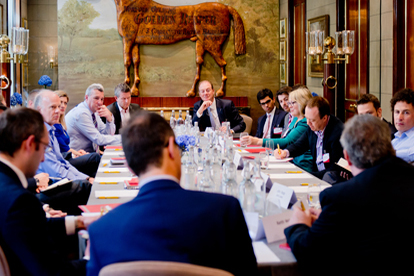Facilitator: Leigh Fisher. Expert: Paul Skinner
Headlines:
- Interest rates are rising, liquidity is tightening. This is likely to be symptomatic over the next 12 – 18 months, and the bond market vigilantes will be looking for the weaknesses, but it’s not going to be easy
- These weaknesses could be within particular corporates, such as the regional US banks where the focus is at present, or certain instrument types or countries
- The market will test where the free liquidity has gone too, as it becomes tougher to find. Liquidity is however just a small part of the fundamental regime shift, as central banks battle with prioritising financial stability over everything else
Discussion Points:
Developed Markets re-cap / outlook
US: The US has probably seen a peak in rates at this part of the cycle. While rates may not come down as quickly as the market has anticipated, it is likely that the next move will be to reduce levels. The long-held supremacy of the US may well be at an end in terms of economic performance, as confidence crumbles. This will result in a slowdown, which supports the cause for a rate cut and will dramatically change fixed income investing.
Europe: In Europe, credit conditions remain firm and positive. We have not seen the same level of confidence erosion despite the collapse of a large Swiss bank. The recovery of China is fundamentally vital for European manufactured goods. The European Central Bank is being slow to raise rates whilst acknowledging the inflation issue. This gives us all the ingredients for a strong outperformance for Europe.
UK: The Bank of England has been reluctant on raising rates, despite the UK economy having the largest inflationary environment of all the developed markets.
Inflation cycles will become more aggressive and more frequent.
The regime is changing. For the last 20 years, we have lived in a low growth, low inflation environment, sitting at around 0.5 – 2%. The world has benefitted from Chinese labour – a deflationary force – and a downdraft from globalisation and the economies of scale it has bought. Central banks could simply react to any issue by lowering rates and increasing liquidity.
We are now moving back to the old days of cyclical behaviour, with high growth and high inflation in the region of -1 – +6%. Central banks are taking a “slam the brakes on” approach, before restarting their engines again. Secular drivers mean that inflation will be more of an issue, partly due to the withdrawal of globalisation that peaked over a decade ago.
Prices for goods are increasing, and labour workforces in developed markets are decreasing. What we can expect to see is a higher inflation paradigm with more frequent and more volatile cycles. Central banks are reacting differently to each other and at different times, and this increased separation is causing further dispersion in regions, countries and companies.
Investors can no longer rely on buying risk assets and will have to change the way they invest, becoming more nimble, more active, and more liquid in order to drive returns.
Cause and Effect: Looking at climate change
Another key change we continue to see is the focus on climate change and its effect on investment markets. Many firms are now incorporating sustainable investing into their processes. Climate change, and the sub-themes that sit within this diverse area, are an area Wellington are paying particular attention.
Wellington partner with Woodwell Climate Research Centre, the pre-eminent climate change research institution based in the US. They have helped to map the world into 50km squares, to look at how each of these areas will be affected by climate change over investible time horizons. They include chronic climate effects, such as heat, and acute effects such as flooding. Wellington can then analyse how climate risk factors are expected to affect those companies in which they invest.
One of the major issues this year is that the potential for an El Nino effect has risen to 95%, and there is a high chance that this could actually be a Super El Nino – an El Nino with teeth! These events occur where the oceans are not absorbing the heat from the sun, resulting in air temperatures 0.2 – 0.5 degrees higher than normal. This causes very wet weather in the tropics, droughts in Northern Europe and extremely cold winters.
Insights such as this allow Wellington to look at how to distribute their investments, as well as at investment opportunities, such as a hydro-electric company based in Spain, helping to combat the threat of drought.
When investing for sustainability, outcomes need to be measurable… and not just to share with clients! Clients deserve to see the direct impact their investments are making, and not simply performance versus a benchmarked return.
Portfolio managers also need to be evidencing the sustainability benefits of their investments, enabling them to engage or disinvest should the impact of their investment not be as expected.
Key takeaways:
- With an expectation of greater cyclicality, dispersion, and structurally higher and more volatile inflation, investors should place increasing value on liquidity and active management, focusing on being nimble to adjust to a quickly changing market
- Wellington are looking to work collaboratively with other Net Zero aligned stakeholders to drive real economic change, but firms, regulators, and the industry can do more
- Whilst it’s difficult and potentially unnatural for competing firms to share information, everyone should be asking: “How should we measure impact?”, “What are the metrics we should be looking at?”, and “How do we build a regimented and standardised way of displaying and sharing this information?”


